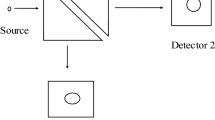Abstract
The apparent underdetermination of the formalism of quantum field theory (QFT) as between a particle and a field interpretation is studied in this paper through a detour over the problem of unifying QFT with general relativity. All we have at present is a partial or approximate unification, QFT in non-Minkowskian spaces. The nature of this hybrid and the problem of its internal consistency are discussed. One of its most striking implications is that particles do not have an observer-independent existence. We trace the ways in which physicists reacted to this at first highly implausible ontological consequence. We conclude that quantum fields rather than particles are after all the basic entities in QFT.
Similar content being viewed by others
References
Ashtekar, A. and R. Geroch: 1974, ‘Quantum Theory of Gravitation’,Rep. Prog. Phys. 37, 1211–56.
Ashtekar, A. and A. Magnon: 1975, ‘Quantum Fields in Curved Space-Times’,Proc. Roy. Soc. A346, 375–94.
Audretsch, J.: 1981, ‘Quantum Gravity and the Structure of Scientific Revolutions’,Zeitschrift fur Allgemeine Wissenschaftstheorie 12, 322–39.
Audretsch, J.: 1989, ‘Vorläufige Physik und andere pragmatische Elemente der modernen Physik’, in H. Stachowiak (ed.),Pragmatik: Handbuch pragmatischen Denkens, Meiner, Hamburg (Forthcoming).
Bell, S. and J. M. Leinaas: 1983, ‘Electrons as Accelerated Thermometers’,Nucl. Phys. B212, 131–50.
Birrell, N. D. and P. C. W. Davies: 1982,Quantum Fields in Curved Space, Cambridge University Press, Cambridge.
Brandenberger, R. H.: 1985, ‘Quantum Field Theory Methods and Inflationary Universe Models’,Rev. Mod. Phys. 57, 1–60.
Davies, P. C. W.: 1976, ‘Quantum Field Theory in Curved Space-Time’,Nature 263, 377–80.
Davies, P. C. W.: 1984, ‘Particles Do Not Exist’, in S. M. Christensen (ed.),Quantum Theory of Gravity, A. Hilger, Bristol, pp. 66–77.
De Witt, B. S.: 1975, ‘Quantum Field Theory in Curved Space-Time’,Phys. Rep. 19, 295–357.
De witt, B. S.: 1979, ‘Quantum Gravity: The New Synthesis’, in S. W. Hawking et al., (eds.),General Relativity. Cambridge University Press, Cambridge, pp. 680–745.
Duff, M. J.: 1981, ‘Inconsistency of Quantum Field Theory in Curved Space-Time’, in C. J. Isham et al. (eds.),Quantum Gravity 2, Oxford University Press, Oxford, pp. 81–105.
Earman, J.: 1981, ‘Combining Statistical Thermodynamics and Relativity Theory: Methodological and Foundations Problems’, inPSA 1978, Vol. 2, pp. 157–85.
Eppley, K. and E. Hannah: 1977, ‘The Necessity of Quantizing the Gravitational Field’,Foundations of Physics 7, 51–68.
Fulling, S. A.: 1973, ‘Nonuniqueness of Canonical Field Quantization in Riemannian Space-Time’,Phys. Rev. D7, 2850–62.
Fulling, S. A.: 1983, ‘Two-Point Functions and Renormalized Observables’, in K. Kikkawa et al. (eds.),Gauge Theory and Gravitation. Springer-Verlag, Berlin, pp. 101–6.
Fulling, S. A.: 1984, ‘What Have We Learned from Quantum Field Theory in Curved Space-Time?’, in S. M. Christensen (ed.),Quantum Theory of Gravity, A. Hilger, Briston, pp. 42–52.
Gibbons, G. W. and S. W. Hawking: 1977, ‘Cosmological Event Horizons, Thermodynamics, and Particle Creation’,Phys. Rev. D15, 2738–51.
Hawking, S. W.: 1975, ‘Particle Creation by Black Holes’,Commun. Math. Phys. 43, 199–220.
Isham, C. J.: 1977, ‘Quantum Field Theory in Curved Space-Time’,8th Texas Symposium on Relativistic Astrophysics, New York, [Ann. NY Acad. Sci. 302], pp. 114–57.
Joseph, G.: 1980, ‘The Many Sciences and the One World’,Journal of Philosophy 77, 773–91.
Kimble, T. W. B.: 1981, ‘Is a Semi-Classical Theory of Gravity Viable?’, in Isham et al. (eds.),Quantum Gravity 2, Oxford University Press, Oxford, pp. 63–80.
Koertge, N.: 1971, ‘Inter-Theoretic Criticism and the Growth of Science’, inPSA 1970, D. Reidel, Dordrecht, pp. 160–73.
Redhead, M. G.: 1983, ‘Quantum Field Theory for Philosophers’, inPSA 1982, Vol. 2, pp. 57–99.
Redhead, M. G.: 1988, ‘A Philosopher Looks at Quantum Field Theory’, in H. Brown et al. (eds.),Philosophical Foundations of Quantum Field Theory, Oxford University Press, Oxford, pp. 9–23.
Rohrlich, F. and L. Hardin: 1983, ‘Established Theories’,Philosophy of Science 50, 603–17.
Rüger, A.: 1988, ‘Atomism from Cosmology. Schrödinger's Work on Wave Mechanics and Space-time Structure’,Historical Studies in the Physical Sciences 18, 377–401.
Sciama, D. W., P. Candelas and D. Deutsch: 1981, ‘Quantum Field Theory, Horizons and Thermodynamics’,Advances in Physics 30, 327–66.
Stöckler, M.: 1984, ‘9 Thesen zum Dualismus von Welle und Teilchen’, in B. Kanitscheider (ed.),Moderne Naturphilosophie, Würzburg, pp. 223–42.
Teller, P.: 1983a, ‘Quantum Physics, the Identity of Indiscernibles and Some Unanswered Questions’,Philosophy of Science 50, 309–19.
Teller, P.: 1983b, ‘Comments on the Papers of Cushing and Redhead’, inPSA 1982, Vol. 2, pp. 100–11.
Unruh, W. G.: 1976, ‘Notes on Black Hole Evaporation’,Phys. Rev. D14, 870–92.
Wald, R. M. and W. G. Unruh: 1984, ‘What Happens When an Accelerating Observer Detects a Rindler Particle’,Phys. Rev. D29, 1047–56.
Wald, R. M.: 1984,General Relativity, University of Chicago Press, Chicago.
Wald, R. M.: 1986, ‘Correlations and Causality in Quantum Field Theory’, in R. Penrose et al. (eds.),Quantum Concepts in Space and Time, Oxford University Press, Oxford, pp. 293–301.
Weinberg, S.: 1977, ‘The Search for Unity: Notes for a History of Quantum Field Theory’,Daedalus 106, 17–35.
Author information
Authors and Affiliations
Additional information
I should like to thank Professors Jürgen Audretsch, Paul Teller and Dr. Martin Carrier for helpful comments.
Rights and permissions
About this article
Cite this article
Rüger, A. Complementarity meets general relativity: A study in ontological commitments and theory unification. Synthese 79, 559–580 (1989). https://doi.org/10.1007/BF00869287
Issue Date:
DOI: https://doi.org/10.1007/BF00869287




